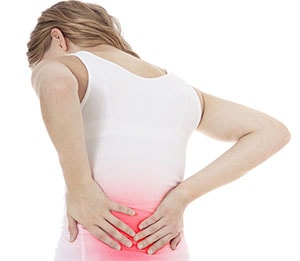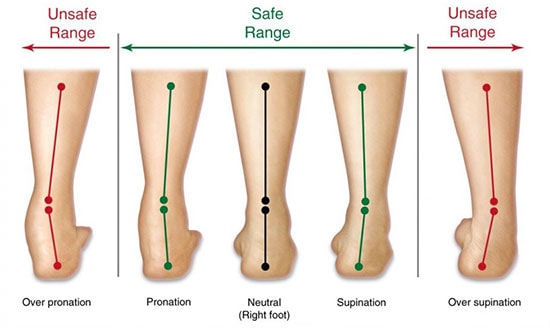What is pronation? It’s a complex biomechanical concept that describes the rotational motion of the medial bones in the mid-foot, downward and inward with each step. It facilitates proper posture in the spine and assists with shock absorption while walking, jogging, or running in able-bodied children and adults.
Pronation: it’s the regular, rolling motion your foot experiences when you take a step.
However, overpronation – and its sister, underpronation – commonly result in foot, ankle, calf, and lower back pain, if left unaddressed.
The problem isn’t so much one of gait as it is of weight distribution. “As much as we like to think about human bodies as machines, we know that in reality, bodies are imperfect and asymmetrical,” says Suzanne Hawson, PT. “While some degree of over- and underpronation is to be expected in most people, excessive rotational motion one way or the other can increase the risk of overuse and stress injuries.”
What Causes Overpronation?
Overpronation refers to the tendency of the medial bones to rotate inward too much, causing the arch to flatten. Underpronation, also known as supination, refers to the opposite. We’ll talk a little bit more about supination in our next blog.
While genetics and poor running form can contribute to overpronation, experts attribute the prevalence of overpronation to three main characteristics of modern living:
- Unsupportive footwear
- Muscular weakness in the legs
- Hard, flat surfaces of sidewalks, homes, and workplaces.
These factors loosen joints in the foot over time, causing structural changes to the bones and soft tissues. These changes then influence the “kinetic chain,” affecting the body’s ability to distribute weight to properly absorb the shock of movement.
Signs and Symptoms of Overpronation

- Pain which stems from the bottoms of the feet and heels and spreads to the thighs and back
- Stiffness in the feet or legs
- Swelling in the heel or ankle
Common Injuries of Overpronators
When walkers and runners overpronate, the big toe and the second toe absorb too much shock, and take on too much of the work on push-off. As a result of this imbalance of pressure, overpronators are more susceptible to stress injuries such as:
- Shin splints
- Runner’s knee
- Stress fractures
- Plantar fasciitis
- Achilles tendinitis
Treatment for Overpronation
Wear supportive shoes. Did you know that the Brooks Chariot, released in 1982, was the very first running shoe developed to address overpronation in runners?

You can still buy a version that pays homage to the style of the classic Chariot in men’s and women’s sizes, but the shoe is no longer designed for performance.
Today, look for shoes with thick, firm, multi-density soles, and “motion stability.” These can stop your foot from rolling too far inward.
Use orthotic inserts. In many cases, you don’t have to buy completely new footwear. Overpronators can visit their foot and ankle specialist for an evaluation and a custom insert fitting.
Orthotic inserts can lift your arches and cut short the inward rolling motion. This will help to distribute weight evenly across the foot and correct alignment.
Stretching and foam rolling. If your doctor says it’s okay, you can use a foam roller to roll out the tightness in your calves that can exacerbate problems associated with overpronation.
Stretching can help reduce pain and increase your range of motion. Here are some stretches you can try at home.
- Toe and heel lifts
- Calf raises
- Toe touches
- Ankle rolls
While foam rolling and stretching the legs can help with the pain, no amount of physical therapy can “fix” overpronation. Think of the inserts as you would eyeglasses. Eyeglasses can improve eye functionality in people with poor vision, but you can’t significantly strengthen the eye muscles through exercise.
Tune in next week, when we’ll go in-depth on a related posture issue: underpronation, or supination!
Why choose University Foot and Ankle Institute for your foot and ankle care?
If you are experiencing any type of foot, toe, or ankle problems, we’re always here to help. At UFAI, our mission is to provide the best available treatment techniques. We want our patients to be pain-free and back to their daily activities as soon as possible.
Our nationally recognized, board-certified Doctors of Podiatric Medicine (DPMs) and foot and ankle surgeons offer the most advanced care and the highest success rates in the nation. We are leaders in the research and treatment of all foot and ankle conditions.
For more information, or to schedule a consultation, please call (877) 736-6001 or make an appointment online now.
At UFAI, we take our patients’ safety seriously. Our clinics’ and surgery centers’ Covid-19 patient safety procedures exceed all CDC recommendations during this coronavirus pandemic. Masks are required in our institutes at all times.
We are conveniently located throughout Southern California and the Los Angeles area. Our doctors are available at locations in or near: Santa Monica, Beverly Hills, West Los Angeles, Manhattan Beach, Northridge, Downtown Los Angeles, Westlake Village, Granada Hills, and Valencia.
- Revolutionizing Extremity Imaging: UFAI’s Open MRI for the Foot and Ankle - October 21, 2023
- Youth Sports and Heel Pain: Should Kids Play with Pain? - April 4, 2023
- All About Foot Arch Pain and Foot Arch Cramps - March 15, 2021

I agree with you that Unsupportive footwear can be a cause of lower back pain and overpronation, not all footwear is comfortable for our foot. Orthotic inserts, Stretching and foam rolling is really effective to avoid lower back pain and overpronation.
People don’t realize that pain originates in joint and arches. Orthotics can lift your arches and will help to distribute weight across the foot. This will definitely give you relief from pain.